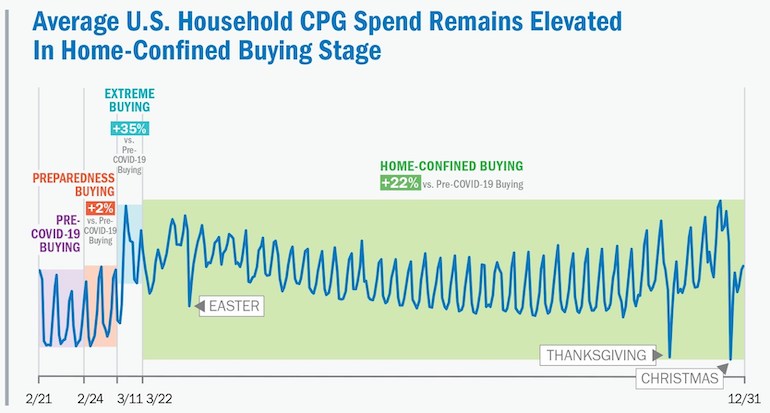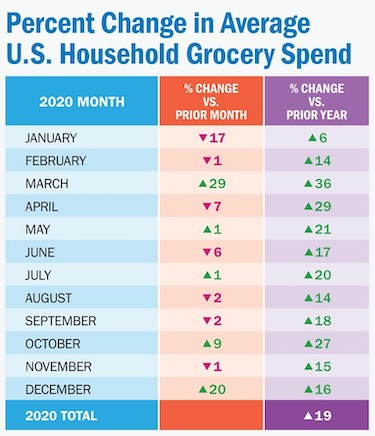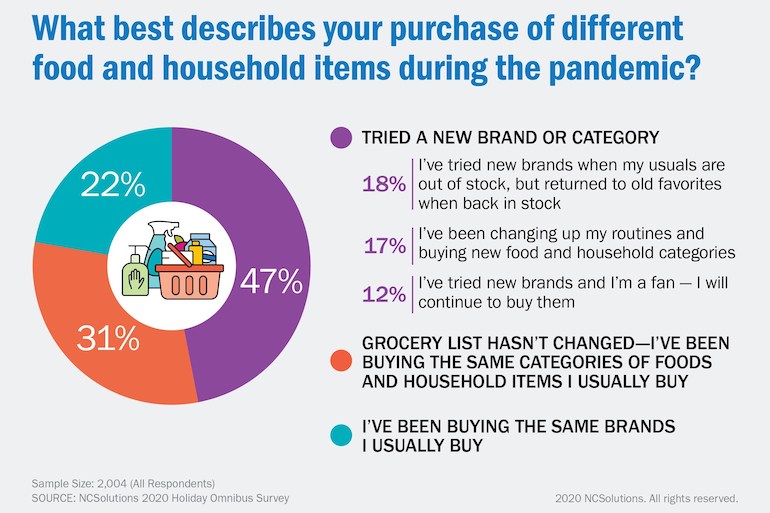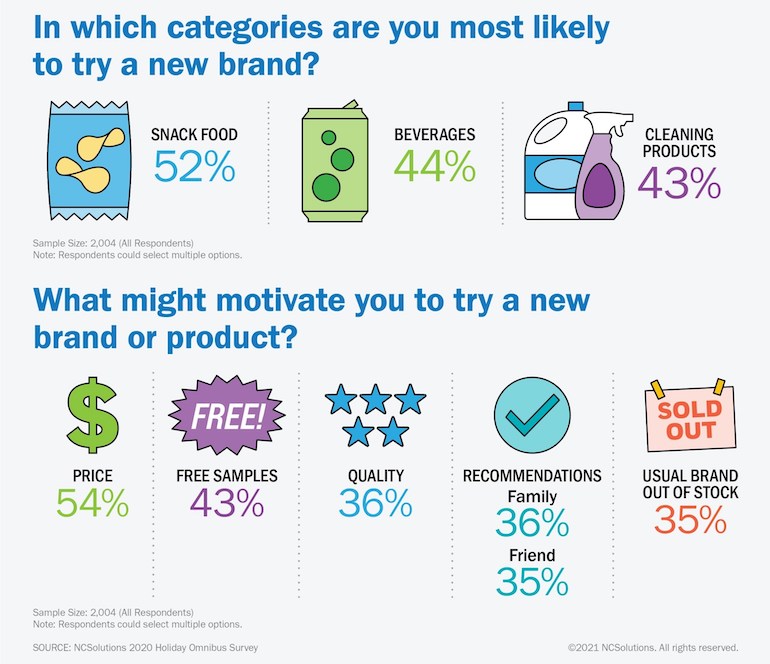Driven by the COVID-19 crisis, U.S. household spending on consumer packaged goods swelled 19% in 2020 and remained elevated heading into 2021, according to new research from advertising efficacy specialist NCSolutions.
Americans also have shown a greater predilection for new CPG items as they’ve hunkered down at home, with nearly half of those surveyed by NCSolutions reporting that they’ve tried a new brand or product category.

New York-based NCSolutions identified three phases of pandemic-related grocery spending in 2020. U.S. household CPG spending rose 2% from pre-pandemic levels for the “preparedness buying” period of Feb. 24 to March 11 as reported cases of COVID-19 popped up around the country. Next came the “extreme buying” phase of consumer stockpiling as coronavirus was declared a national emergency, which saw CPG expenditures jump 35% versus pre-COVID buying.
The “home-confined buying” period then began on March 22 and continued to the year-end, with CPG expenditures up 22% as most consumers locked down at home, with some elevated spending around holidays like Easter, Thanksgiving and Christmas/New Year’s.
Although grocery spending growth fluctuated — sometimes sharply — on a month-to-month basis during 2020, year-over-year CPG spending gained by double-digits in every month except January, NCSolutions’ purchase data showed.
Five months saw year-over-year increases of 20% or more: March (+36%), April (+29%), May (+21%), July (+20%) and October (+27%). The largest month-to-month growth in CPG spend came in March (+29%), December (+20%) and October (+9%).

In the final quarter of 2020, U.S. household grocery spending grew 9.3% month to month on average. Year-over-year growth averaged 19.3% over the three months, closing out the year with a 16% increase in December.
The change in CPG purchasing habits in 2020 amid the pandemic came not just in how much consumers spent, but also on what they bought, NCSolutions noted.
Of more than 2,000 U.S. adults polled, 47% said they tried new food and household brands and categories since the coronavirus outbreak. Eighteen percent of those shoppers reported trying new brands when their regular item was out of stock and then later returning to their favorites when they again became available.
Meanwhile, 17% said they’ve “changed their routine” by buying items in new food and household categories, and 12% indicated that they will stick with the new brands they’ve purchased.
“The increase in CPG spending coupled with the openness of consumers for new brands marks a clear opportunity for brands,” NCSolutions CEO Linda Dupree said in a statement. “Since the start of the pandemic, our teams at NCSolutions have identified several trends emerging with respect to brand loyalty. Consumers are purchasing their favorite brands in greater quantities and at higher frequencies than before the pandemic, but they’re also more willing to experiment with competitive brands as they tire of pandemic living.”

By CPG category, survey respondents were most open to trying a new brand in snack foods. Fifty-two percent said they’d be most willing to experiment with new options in snacks, followed by beverages (44%) and cleaning products (43%).
The main motivation to try something new was price, cited by 54% of consumers polled. Other factors swaying respondents to try a new brand or product included free samples (43%), quality (36%), recommendations (36% family, 35% friend) and out-of-stocks (35%).
“In response to these trends, many brands are refocusing their advertising efforts through the lens of brand loyalty,” Dupree added. “Some brands are doubling down on both their most loyal and newest buyers, focusing on these audiences to retain them, move them up the loyalty ladder and prevent them from straying to competitive brands.”

Higher food-at-home spending also has impacted Americans’ meal planning, though the COVID lockdowns have made some tired of their meal routines, NCSolutions found. Thirty-six percent of consumers reported that they’re seeking out new ideas for meals, while 24% are prioritizing healthy eating. Still, 34% said they eat the same meals regularly, and 13% indicate boredom with their current meal rotation.
To invigorate their daily routines, 41% of consumers surveyed are open to trying new recipes and products. The willingness to experiment is even greater among those seeking new meal ideas, with 67% of this group open to new recipes and products. NCSolutions pointed out that many consumers said these behaviors were triggered by the pandemic.
Even with a greater willingness to explore, consumers are buying their favorite brands in bigger quantities and at higher frequencies than before the pandemic, the survey revealed. Thirty-one percent of shoppers said their grocery lists haven’t changed since the COVID-19 outbreak, 22% are buying the same brands as usual and 18% are returning to favorite items once back in stock.
“As consumers continue to experiment with new products and categories while also clinging to old favorites, loyalty disruptions persist into the pandemic. As a result, it’s crucial for brands to understand the makeup of their buyers,” according to Lance Brothers, chief revenue officer at NCSolutions. “There is a need now more than ever for brands to more closely evaluate their own standing with customers.”





